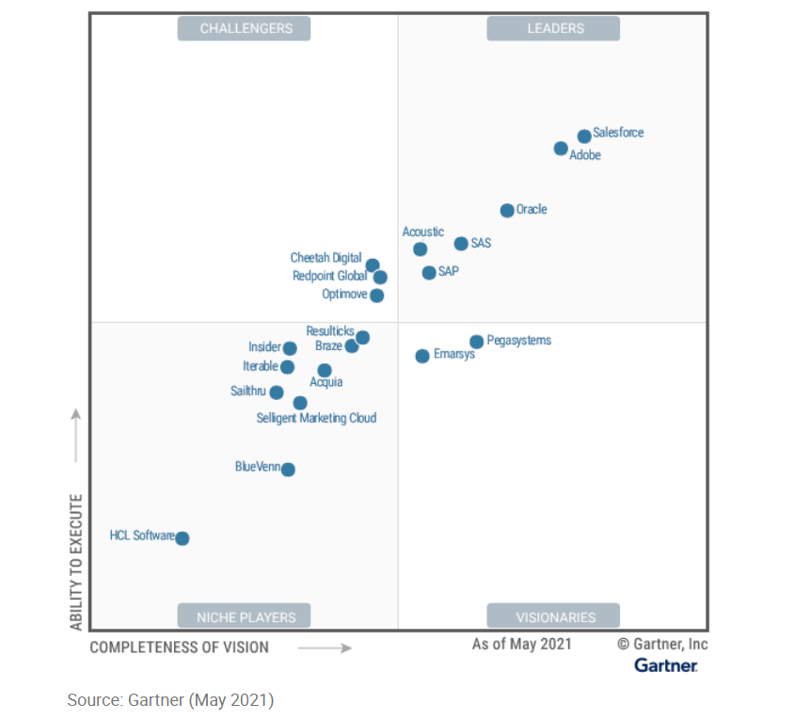Viewpoint: The latest Gartner Magic Quadrant for Multi-Channel Marketing Hubs
In early May every year, I find myself looking forward to the release of the new Gartner Magic Quadrant for Multi-Channel Marketing Hubs (MMH) report the way other people look forward to the Eurovision Song Contest or Royal Ascot.
For the uninitiated, the Magic Quadrant is a set of market research reports published by Gartner, that seek to quantify and analyse the key players in a given industry using clear, measurable data to identify the clear leaders, and those who need to give some serious thought to upping their game. There are hundreds of Magic Quadrants now for diverse industries, but the one that is closest to my heart, as Managing Director of a Marketing Automation supplier to many of the FTSE 500 will always be the Multi-Channel Marketing Hubs (MMH) report.
This year, just for fun (I use that word very loosely of course), I thought I would share a little about how I interpret the report, and what I look for when assessing the Marketing Automation landscape. I should add, I already have my carefully formed opinions, and have never subscribed to the Churchillian “If I want your opinion I will give it to you” aphorism, but it’s always nice to get a little bit of validation that I’m not alone in where I see the industry is going.
Before we get into it, we should repeat the usual legal disclaimer on Gartners behalf, since we’ll be discussing their findings:
“Gartner does not endorse any vendor, product or service depicted in its research publications, and does not advise technology users to select only those vendors with the highest ratings or other designation. Gartner research publications consist of the opinions of Gartner’s research organization and should not be construed as statements of fact. Gartner disclaims all warranties, expressed or implied, with respect to this research, including any warranties of merchantability or fitness for a particular purpose.”
Of course, first we head straight to the actual magic quadrant diagram for the quick visual overview.

The two clear leaders, again are Salesforce (with their ‘Marketing Cloud‘ product) and Adobe (with their ‘Campaign‘ product). They have, interestingly switched places, where in 2020 Adobe were slightly in front with a more well-rounded offering with great integration capabilities, now Salesforce have stolen a march on them.
It’s not hard to see why Salesforce are creeping ahead. 2020 saw Salesforce profits increase by more than 20%, at a time when other technology vendors were contracting or consolidating. They launched their own CDP (Customer Data Platform – now called Salesforce CDP (formerly known as C360 Audiences), while deepening the connectivity between components like Datorama & Tableau. That said, Adobe Campaign are markedly top right for very good reasons. Their supremacy over all things content related, the launch of Journey Optimiser and improved real time ‘next best action’ offerings are taking the world of Marketing Automation by storm.
Other top-right players include SAP, SAS, Oracle and Acoustic. It’s really great to see Acoustic holding their own against the major players. Their laser focus on great customer experience and digital journey management is paying dividends. HCL Unica for the second year running is bringing up the rear of the pack. It’s a shame to see, having worked alongside some really great people producing great solutions to clients problems, with a product maturity that other vendors can only dream of. It is clear there is still some catching up to do after languishing for years under the yoke of Big Blue to win again the hearts and minds of the CMOs of the world.
It’s really important to look at the entire report though, not to just take the Marketing Automation industry at face value from a single visual air – you’re better than that. It’s essential to review, consider the strengths and cautions of all the key players, certainly everyone in the top right ‘Leaders’ box. When planning your companies next big move in the Marketing Automation world, look closely into whether a technology vendors strengths align with your own strategic priorities, whether the cautions are anything you’d consider a worry for your particular vertical at your departments current stage of maturity. Often it isn’t, but it never hurts to ask yourself the questions, while it can hurt to avoid them.
As a vendor agnostic consultancy, Purple Square are experts in MarTech migration for the Marketing Automation space. Changing your MarTech is a risky business, let Purple Square be your insurance policy. For more information why not get in touch today, and for the full Gartner report, click here.
Like what you see?
Subscribe to our newsletter for customer experience thought leadership and marketing tips and tricks.




